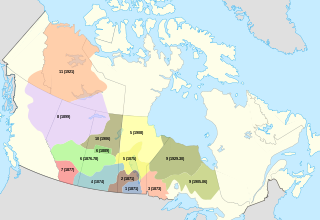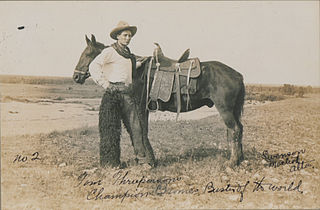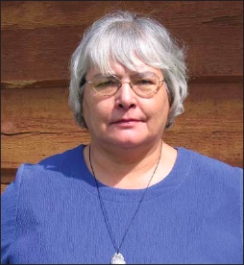
The Blackfoot Confederacy, Niitsitapi, or Siksikaitsitapi, is a historic collective name for linguistically related groups that make up the Blackfoot or Blackfeet people: the Siksika ("Blackfoot"), the Kainai or Blood, and two sections of the Peigan or Piikani – the Northern Piikani (Aapátohsipikáni) and the Southern Piikani. Broader definitions include groups such as the Tsúùtínà (Sarcee) and A'aninin who spoke quite different languages but allied with or joined the Blackfoot Confederacy.

The Kainai Nation is a First Nations band government in southern Alberta, Canada, with a population of 12,800 members in 2015, up from 11,791 in December 2013.

The Blackfoot language, also called Siksiká, often anglicised as Siksika, is an Algonquian language spoken by the Blackfoot or Niitsitapi people, who currently live in the northwestern plains of North America. There are four dialects, three of which are spoken in Alberta, Canada, and one of which is spoken in the United States: Siksiká (Blackfoot), to the southeast of Calgary, Alberta; Kainai, spoken in Alberta between Cardston and Lethbridge; Aapátohsipikani, to the west of Fort MacLeod which is Brocket (Piikani) and Aamsskáápipikani, in northwestern Montana. The name Blackfoot probably comes from the blackened soles of the leather shoes that the people wore.

The Pi'ikanni Nation is a First Nation, representing the Indigenous people in Canada known as the Northern Piikani or simply the Peigan.

The Three Sisters are a trio of peaks near Canmore, Alberta, Canada. They are known individually as Big Sister, Middle Sister and Little Sister.

Treaty 7 is an agreement between the Crown and several, mainly Blackfoot, First Nation band governments in what is today the southern portion of Alberta. The idea of developing treaties for Blackfoot lands was brought to Blackfoot chief Crowfoot by John McDougall in 1875. It was concluded on September 22, 1877, and December 4, 1877. The agreement was signed at the Blackfoot Crossing of the Bow River, at the present-day Siksika Nation reserve, approximately 75 km (47 mi) east of Calgary, Alberta. Chief Crowfoot was one of the signatories to Treaty 7. Another signing on this treaty occurred on December 4, 1877, to accommodate some Blackfoot leaders who were not present at the primary September 1877 signing.
First Nations in Alberta are a group of people who live in the Canadian province of Alberta. The First Nations are peoples recognized as Indigenous peoples or Plains Indians in Canada excluding the Inuit and the Métis. According to the 2011 Census, a population of 116,670 Albertans self-identified as First Nations. Specifically there were 96,730 First Nations people with registered Indian Status and 19,945 First Nations people without registered Indian Status. Alberta has the third largest First Nations population among the provinces and territories. From this total population, 47.3% of the population lives on an Indian reserve and the other 52.7% live in urban centres. According to the 2011 Census, the First Nations population in Edmonton totalled at 31,780, which is the second highest for any city in Canada. The First Nations population in Calgary, in reference to the 2011 Census, totalled at 17,040. There are 48 First Nations or "bands" in Alberta, belonging to nine different ethnic groups or "tribes" based on their ancestral languages.
The economy of Lethbridge is central to the commercial, distribution, financial and industrial sectors of the southern Alberta economy. Lethbridge has a trading area population of 250,000. The city was founded in 1885 as a result of local coal mining and later was buoyed by local farming and ranching. Toward the end of the twentieth century, the local economy started diversifying by focusing more on service-based industries.

Blood 148 is a First Nations reserve in Alberta, Canada. It is inhabited by the Blood (Kainai) First Nation and was established under the provisions of Treaty 7. This reserve is managed from the community of Stand Off on its northwest border and encompasses the majority of lands bounded by the cities of Fort MacLeod, Lethbridge and Cardston. It is traversed by Alberta Highway 2, Highway 5, and Highway 509. The St Mary River and the Belly River are major rivers supplying and draining the lands.
Hugh Aylmer Dempsey, was a Canadian historian, an author and the Chief Curator Emeritus of the Glenbow Museum in Calgary, Alberta. Dempsey authored more than 20 books, focusing primarily on the history of people of the Blackfoot Confederacy. He received an honorary doctorate from the University of Calgary and was made an honorary chief of the Kainai Blackfoot in 1967. For his contributions to the study of the Plains Indians, Dempsey was awarded membership in the Order of Canada in 1975.
The Honourable Eugene Joseph Creighton is a member of the Blood Tribe, or Kainaiawa, which is an integral part of the Blackfoot Confederacy.

Stand Off is an unincorporated community in southern Alberta, Canada within the Blood (Kainai) reserve. It is on Highway 2, approximately 43 km southwest of Lethbridge and 30 km (19 mi) north of Cardston. The people living in Stand Off and on the reserve are a part of the Blackfoot Nation of Canada and the United States. The Blood Tribe (Nation) has the largest landmass in all eleven Numbered Treaties in Canada, (1871–1921).

Faye HeavyShield is a Kainai First Nations sculptor and installation artist. She is known for her repetitive use of objects and writing to create large-scale, often minimal, site-specific installations.

Old Sun Community College is a community college owned and operated by First Nations that provides post-secondary education and training in Siksika 146, Alberta, Canada, to members of the Siksika Nation.

Maskwacis Cultural College (MCC) is a private post-secondary institution within the Four Nations of Maskwacis, Alberta, Canada. MCC offers programs from basic adult literacy, two-year college diplomas, to university transfer programs.

Joane Cardinal-Schubert LL. D was a First Nations artist from Alberta, Canada. She was a member of the Royal Canadian Academy of Arts. She was an activist for Native sovereignty.

Tom Three Persons was a Niitsitapi rodeo athlete and rancher and a member of the Kainai Nation (Blood). Best known for winning the saddle bronc competition at the inaugural Calgary Stampede in 1912. An Indigenous athlete, he was the only Canadian to win a championship at this historic rodeo competition.
Leroy Little Bear is a Blackfoot researcher, professor emeritus at the University of Lethbridge, founding member of Canada's first Native American Studies Department, and recognized leader and advocate for First Nations education, rights, self-governance, language and culture. He has received numerous awards and recognition for his work, including the Officer Order of Canada, and the Alberta Order of Excellence.

Marie Smallface Marule was a Canadian academic administrator, activist, and educator. She served as executive director of the National Indian Brotherhood (NIB), chief administrator of the World Council of Indigenous Peoples (WCIP), and secretary of the Indian Association of Alberta. Marule was president of Red Crow Community College for two decades, and led the creation of several indigenous studies programs. She was previously an assistant professor of Native American studies at the University of Lethbridge.
Gerald Tailfeathers, was one of the first Indigenous Canadians to become a professional painter. His depictions of the “Blood People”, also known as the Kainai people, were brought to life through realism and choice of colours. His work has been described as “romantic, nostalgic, and traditional” due to a majority of his work being in "Studio Style"















